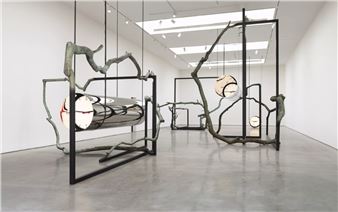True Stories. A Show Related to an Era вҖ“ The Eighties
Galerie Max Hetzler is pleased to announce the group show True Stories. A Show Related to an Era вҖ“ The Eighties, curated by Peter Pakesch. The show will take place both at GoethestraГҹe 2/3 and our temporary space at KurfГјrstendamm 213.
Seen from todayвҖҷs perspective, during this decade, the way art would function in society has changed largely. Within the history of the late 20th Century, the very two years 1968 and 1989 are truly significant for politics as well as for culture. One signifies the height of the Cold War and the departure to new freedoms, the other one the end of this Cold War and the dawn of a new world order (that still is not in place yet).
In a certain reading of Western culture, visual art, as well as other fields of the cultural domain, have come to a certain end by the 1960ties - the end of the Modern. Aesthetics and politics went alongside with this verdict. After some confusion, some years later, artists on both sides of the Atlantic would get a lot of satisfaction by acting against all consequences of history. The end of the вҖҳEnd of ArtвҖҷ around 1980 was experienced as a liberation at least as strong as the move to freedom more than a decade before. The world was to change in an unexpected way. The artist as a strong individual in a world where an individual identity has been revealed as obsolete: that contradiction became enormously productive, creating new strategies and attitudes for artistic challenges.
The exhibition intends to present significant positions of that time and how they were shown in galleries between New York and Los Angeles on one side, as well as Cologne and Vienna on the other side. Those four cities of intellectual importance experienced a growing exchange during that period.

Recommended for you
Galerie Max Hetzler is pleased to announce the group show True Stories. A Show Related to an Era вҖ“ The Eighties, curated by Peter Pakesch. The show will take place both at GoethestraГҹe 2/3 and our temporary space at KurfГјrstendamm 213.
Seen from todayвҖҷs perspective, during this decade, the way art would function in society has changed largely. Within the history of the late 20th Century, the very two years 1968 and 1989 are truly significant for politics as well as for culture. One signifies the height of the Cold War and the departure to new freedoms, the other one the end of this Cold War and the dawn of a new world order (that still is not in place yet).
In a certain reading of Western culture, visual art, as well as other fields of the cultural domain, have come to a certain end by the 1960ties - the end of the Modern. Aesthetics and politics went alongside with this verdict. After some confusion, some years later, artists on both sides of the Atlantic would get a lot of satisfaction by acting against all consequences of history. The end of the вҖҳEnd of ArtвҖҷ around 1980 was experienced as a liberation at least as strong as the move to freedom more than a decade before. The world was to change in an unexpected way. The artist as a strong individual in a world where an individual identity has been revealed as obsolete: that contradiction became enormously productive, creating new strategies and attitudes for artistic challenges.
The exhibition intends to present significant positions of that time and how they were shown in galleries between New York and Los Angeles on one side, as well as Cologne and Vienna on the other side. Those four cities of intellectual importance experienced a growing exchange during that period.
Artists on show
- Albert Oehlen
- Axel Hütte
- Cady Noland
- Christopher Wool
- Cindy Sherman
- Clegg & Guttmann
- Cristina Iglesias
- Didi Sattmann
- Felix González-Torres
- Franz West
- Georg Herold
- Günther Förg
- Heimo Zobernig
- Herbert Brandl
- Inge Mahn
- Isa Genzken
- Jeff Koons
- Julian Schnabel
- Klaus Meuser
- Liz Larner
- Mariella Simoni
- Markus Oehlen
- Martin Kippenberger
- Mathis Esterhazy
- Mike Kelley
- Miroslaw Balka
- Otto Zitko
- Reinhard Mucha
- Richard Prince
- Robert Gober
- Rosemarie Trockel
- Terry Winters
- Thomas Struth
- Werner Büttner
- Wilhelm Schürmann
- Zoe Leonard
Contact details
















